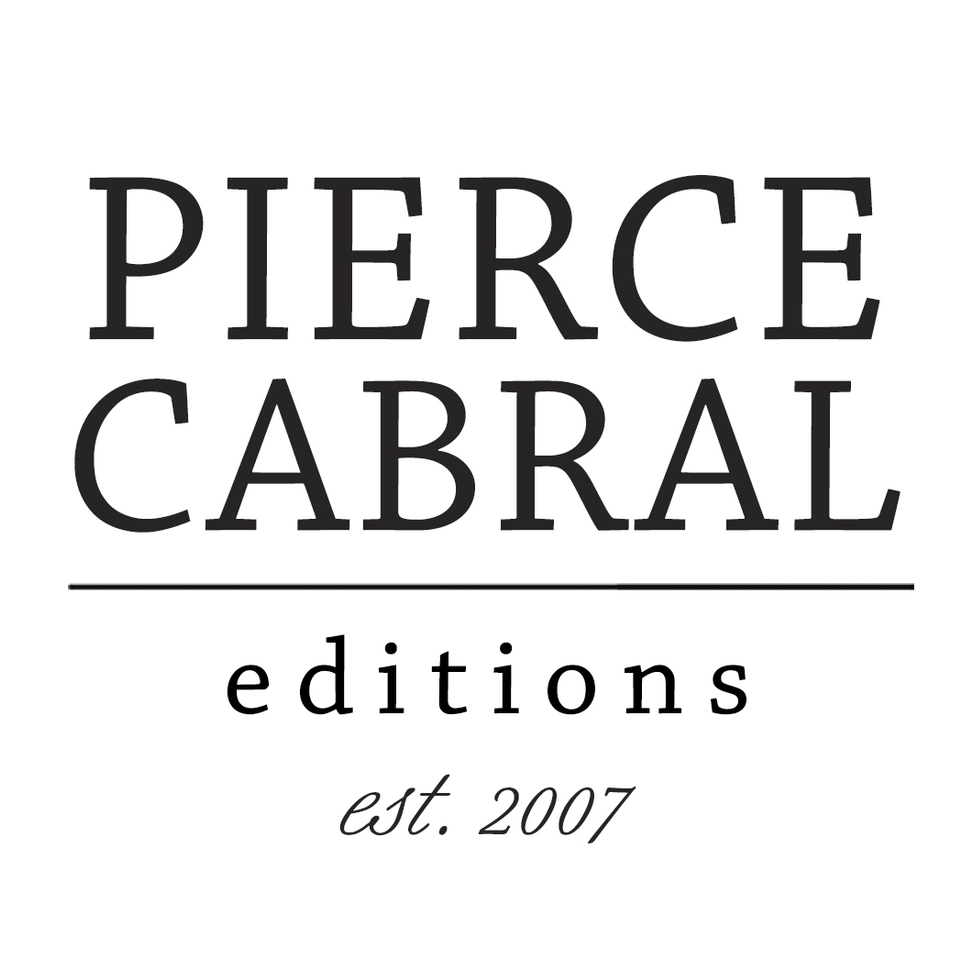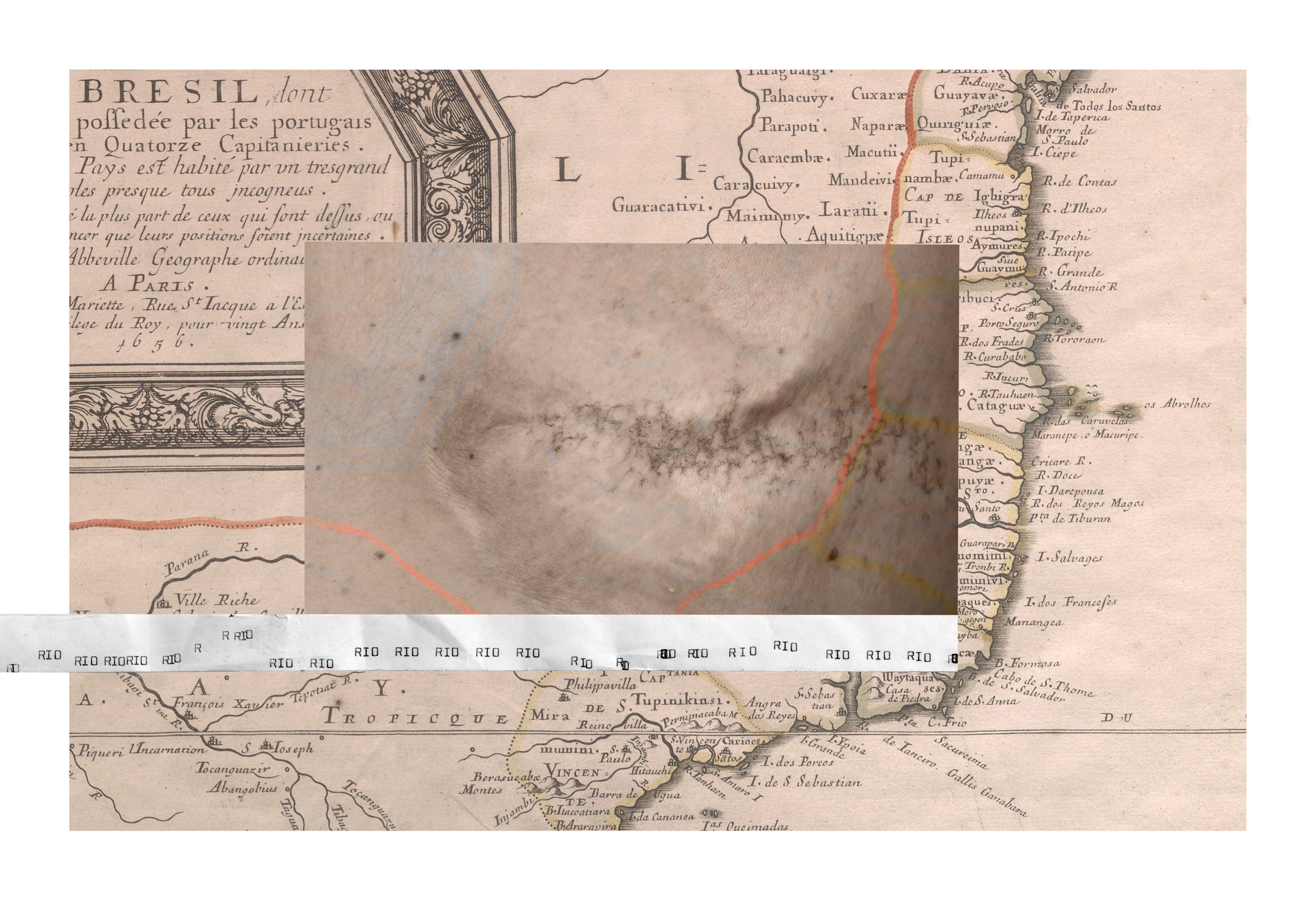RIO/MINE
RIO/MINE
I recreate the telegraph tapes used in the stock market to represent the gradual process in which a river would become a mere ticker symbol of a stock. On these paper strips, I repeat the acronym RIO - the ticker symbol of the shares of Companhia Vale do Rio Doce when, in 2000, it became the first Brazilian company traded on the New York Stock Exchange. RIO has now the same meaning as a mine. This interchangeable meaning of two words, one in Portuguese and one in English, displays in typography the conflicting interests between Brazil and the United States.
This work emerged from my own attempt to understand the international forces that operate the mining industry in Minas Gerais, Brazil. The desire for appropriation of the natural resources in our territory has permeated our history for centuries - from the exploration of gold to iron ore. Such greed is represented here by the use of maps from the United States Library of Congress in which the Brazilian territory is recorded. The Rio Doce river basin is often depicted on these maps, even when knowledge about the vastness of our geography and the richness of our subsoil were still incipient. They wanted emeralds, diamonds, gold, and finally ore. They outlined us to undress us.
There is nothing gentle about this striping. To represent the sequelae and level of morbidity the soil, air and water carry from the exploitation of the mining industry, I make interventions on hydrographic maps of Minas Gerais and insert the image of the scar I carry on my own chest after a cancer diagnosis. I expose the land stripped of its immense riches, but that despite its profound malaise, still in its core seeks healing in every curve of its rivers, just as I seek cure in every curve of my veins.
In this work, the tangled conflicts of domestic Brazilian economic needs and the speculative gains of international investors symbolically overflow the frame as it spreads across the floor in the form of paper streamers. Not unlike when on the streets of the Financial District, ribbons of telegraph tapes from the stock exchange were thrown out the window at important national celebrations. Called “Ticker Tape Parades” such celebrations are usually reserved for American heroes such as the inaugurated president JFK, the astronauts from Mercury and Apollo missions and, select world leaders, among them three Brazilian presidents - Júlio Prestes, Dutra and João Goulart - were decorated between 1930 and 1962, demonstrating the American interests in Brazilian politics in crucial decades of our history.
Prophesied in old colonial agreements, perpetuated in modernizing economic pacts and reinforced by gradual foreign capitalization, the definitive privatization of Brazil’s first and largest iron ore producer - Companhia Vale do Rio Doce - took place in 1997. Foreign hands have shaped this company from its early beginnings. Created in 1942 during the government of President Getúlio Vargas, through financing by the American government and motivated mainly by the need to sustain the US participation in World War II, this mining company has been negotiating its shares in the financial market since1943.
The mining industry’s extractivist nature and its extreme socio-environmental impacting practices culminates with the denationalization of Companhia Vale do Rio Doce and a blind process of autophagy in its relation to land, river and man is unleashed. All it sees are profits. Once privatized, the interests of investors and shareholders prevail. As a multinational, the company saw its market value explode from BRL 7 billion to BRL 200 billion between 2001 and 2010. And so, it begins in its operations in Minas Gerais, the trail of environmental infringements that inevitably generate the unimaginable losses during the tailling dam crimes of Mariana in 2015, and Brumadinho in 2019: both in lives and in rivers.
In 2009, the acronym RIO would be replaced on the stock exchange when the world's largest iron ore producer changed its acronym and company name to VALE, prophesying the unimaginable - the Rio Doce in Minas Gerais, Brazil could one day disappear off the map.
~ Dedicated to D.K.
Where these maps come from?
The maps used in this project come from the a digitized collection from the Library of Congress (LOC) - “The United States and Brazil collection” - a collaboration between the Library of Congress and the National Library of Brazil. It archives interactions between Brazil and the United States going back to the eighteenth century. The United States and Brazil: Expanding Frontiers, Comparing Cultures is either on public domain or have no known copyright restrictions and are free to use and reuse, according to LOC’s website.
Source:
Expanding frontiers, comparing cultures libraries collaborate on U.S.-Brazilian Web Site. Expanding Frontiers, Comparing Cultures (July 2004) - Library of Congress Information Bulletin. (n.d.). Retrieved September 6, 2022, from https://www.loc.gov/loc/lcib/0407/cultures.html
#RIOSHARES
#RIOshares is as much of a hashtag as it is a google search. In 2009, Companhia Vale do Rio Doce removed RIO from its stock ticker symbol. But the monopoly of iron ore production is a small circle - they not only share profits and markets in acquisition schemes and appropriation takeovers but they also happen to exchange ticker symbols too. After VALE S.A. relinquished the ticker symbol RIO from its stocks in 2009, one of largest mining companies in the world gladly absorbed this 3-letter-acronym for its shares. The River became once again a stock.
MAIN BIBLIOGRAPHY:
Bautista Vidal José Walter. (2000). Brasil: Civilização Suicida. Ed. Nação do Sol.
Mikesell, R. F. (1971). Foreign investment in the petroleum and Mineral Industries. Hopkins.
Moura, E., Godeiro, N., Soares, P., & Vieira, V. (2007). Vale do rio doce: Nem Tudo que reluz É ouro: Da privatizaçao à luta pela reestatizaçao. Sundermann.
Pimenta. (1981). A Vale do Rio Doce & sua história. Editoral Vega.
Ragazzi. ROCHA, Lucas Ragazzi. Murillo. (2021). Brumadinho;a Engenharia de Um Crime. EDITORA LETRAMENTO.
Silva, Marta Zorzal E., . (2004). A Vale do rio doce: Na estratégia do Desenvolvimentismo Brasileiro. EDUFES.
Wisnik. (2018). Maquinação do mundo : Drummond e a mineração (1a ed.). Companhia das Letras.
OPEN SOURCE MAPS:
Aa, P. V. D. (1729) Brazil: According to New Surveys by Messrs. of the Royal Academy of Sciences, etc. [Leiden: Publisher Not Identified] [Map] Retrieved from the Library of Congress, https://www.loc.gov/item/2021668297/.
Blaeu, W. J. (1631) New Image of Brazil. [Amsterdam, Holland: publisher not identified] [Map] Retrieved from the Library of Congress, https://www.loc.gov/item/2021668368/.
Carey, M. (1814) A map of Brazil, now called New Portugal. [S.l] [Map] Retrieved from the Library of Congress, https://www.loc.gov/item/2001620474/.
Companhia Lithographica Hartmann-Reichenbach & Calmon, M. (1908) Mappa geral da Republica dos Estados Unidos do Brasil. [S.l] [Map] Retrieved from the Library of Congress, https://www.loc.gov/item/2001620472/.
Cunha, E. A. L., Calmon, M., Gama, A., Luiz, E. D. E., Roosevelt, B. & Roosevelt, T. (1910) Carta da viação ferrea do Brasil. [São Paulo: Secção Geographica Artistica da Compa. Lith. Hartmann-Reichenbach] [Map] Retrieved from the Library of Congress, https://www.loc.gov/item/2003682784/.
Imperial Instituto Artístico. (1902) Brazil, Provincial Railroads. [S.l.: Lith: do Imperial Instituto Artistico, ?] [Map] Retrieved from the Library of Congress, https://www.loc.gov/item/2003627072/.
Matos, J. R. D. C. (1800) Map of Doce and Jequitinhonha Rivers Copied from Documents Found in the House of Representatives. [Place of Publication Not Identified: Publisher Not Identified, to 1839] [Map] Retrieved from the Library of Congress, https://www.loc.gov/item/2021668348/.
Niemeyer, C. J. D., Ponte Ribeiro, D. D. P. R. & Tourinho, M. C. (1873) Map of the Brazilian Empire. [Rio de Janeiro: publisher not identified] [Map] Retrieved from the Library of Congress, https://www.loc.gov/item/2021668361/.
Rocha, J. J. D. (1779) Map of the District of Villa Rica. [Place of Publication Not Identified: Publisher Not Identified] [Map] Retrieved from the Library of Congress, https://www.loc.gov/item/2021668330/.
Sanson, N. (1656) Brazil, which Coast is a Portuguese Possession, Divided into Fourteen Captaincies, Showing the Middle of the Country Inhabited by Many Unknown Peoples. Paris: Chez Pierre Mariette. [Map] Retrieved from the Library of Congress, https://www.loc.gov/item/2021668385/.
Sanson, N. (1656) Le Bresil. Paris. [Map] Retrieved from the Library of Congress, https://www.loc.gov/item/2003627080/.
The November 5th 2015 disaster in Mariana, Minas Gerais is to this day the largest environmental crime in the history of Brazil and the largest in the world involving a tailing dam. The 7th anniversary of the disaster is here and the immeasurable damage it unleashed on those who depend on the Rio Doce is desperately palpable.
Because of the heavy-metal-infested-waters: main municipalities along the river banks have to monitor its water supply; fishing villages can no longer nourish themselves from the fish; and the main indigenous community on the watershed of the Rio Doce - the Krenak people - has to rely on the delivery of food and water trucks for their survival. their culture, spirituality and way of living that has been always connected to the Rio Doce is now indefinetly disturbed.
HELP THE KRENAK @institutosdk
Shirley Djukurnã Krenak belongs to the Krenak indigenous people of eastern Minas Gerais, Brazil. Shirley develops ancestral therapeutic works aimed at healing and at the awakening of the human being. She is a teacher working in partnership with public and private schools, as well as universities and the socio-educational centers. Currently she is coordinating the construction of the “Shirley Djukurnã Krenak Institute”.
FOR INTERNATIONAL DONATIONS:
Citation: Jordi Goya. (2019). INTERVIEW TO SHIRLEY DJUKURNÃ KRENAK Leader, Writer, Social Worker, Environmentalist. Retrieved September 29, 2022, from https://www.youtube.com/watch?v=X1-Biwhps8U&t=2s.
Share the river. Let it be known.
FOLLOW IT ON INSTAGRAM



















